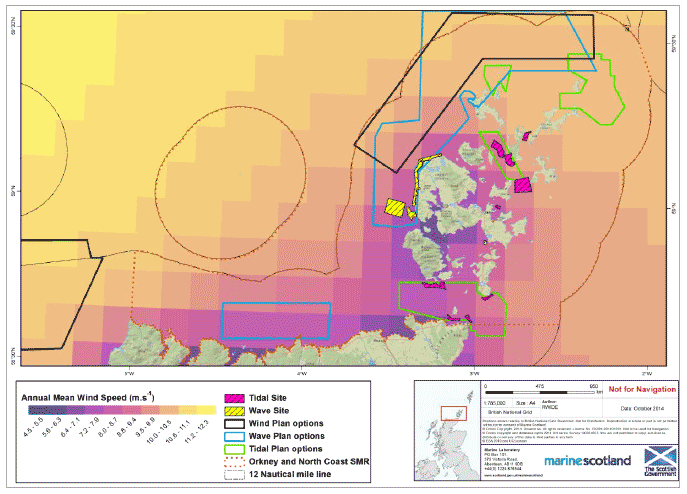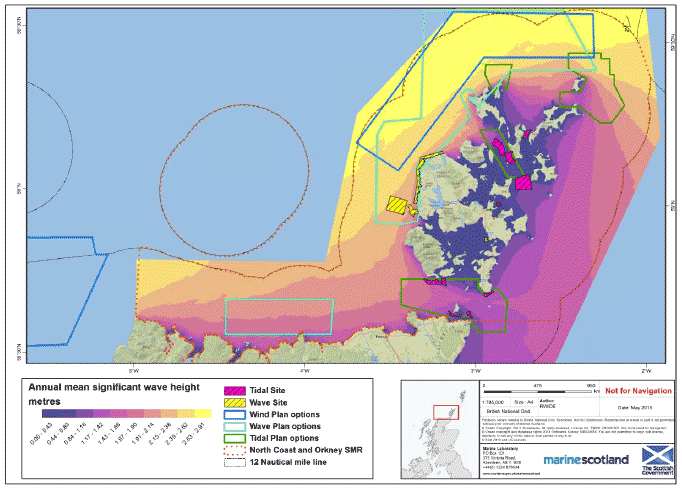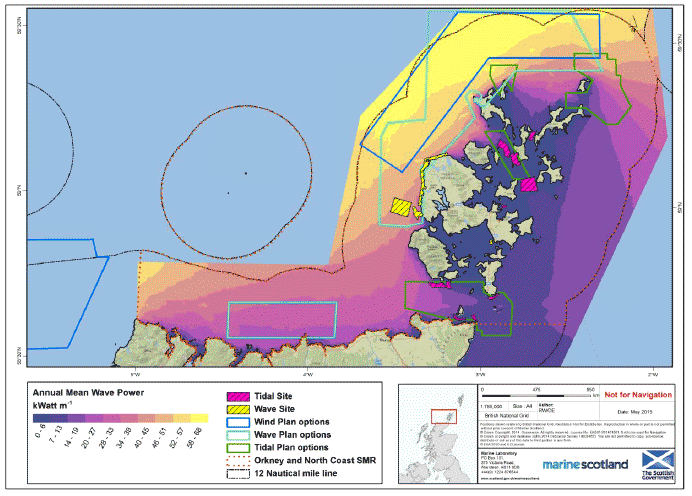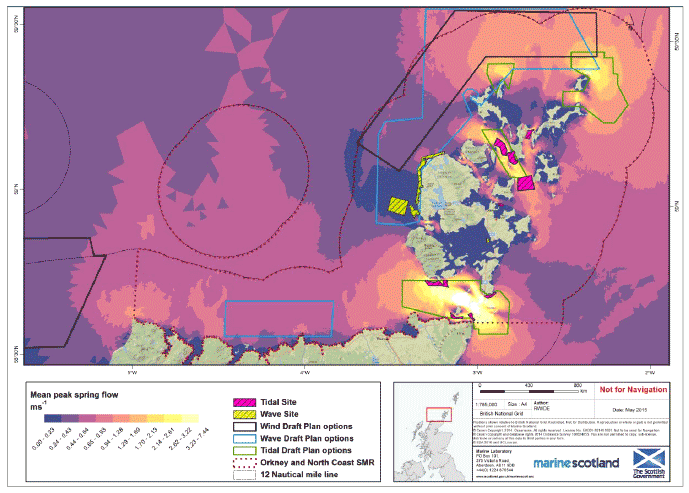Pilot Pentland Firth and Orkney Waters Marine Spatial Plan - Regional Locational Guidance
This Regional Locational Guidance collates information from a wide variety of sources to assist the wind, wave and tidal energy developers in situating their developments.
3 Resource
3.1 Wind resource
North of Orkney ( OWN1)
3.1.1 Wind resource is strong directly north of Orkney in OWN1. The data provided are taken from the ABPmer Atlas of UK Marine Renewable Energy Resource [4] ( ABPmer, 2008) which provides quantitative descriptions of wind resource at 100 m height.
3.1.2 The mean annual wind power densities that can be expected at this location area maximum of 1.40 kWm -2 and a minimum of 0.72 kWm -2. Mean annual power densities are 1.28 kWm -2. Mean annual wind speeds are 10.29 ms -1 in this area.
3.1.3 Summer mean wind power density is 0.56 kWm -2 from 7.85 ms -1 mean wind speed and winter mean power density is four times that at 1.97 kWm -2 from a mean winter wind speed of 12.38 ms -1. Figure 3 shows the geographic variability of the wind resource in the PFOW area.
Figure 3: Mean annual wind speed (ms -1) in the PFOW area.

3.2 Wave resource
North Sutherland Coast ( WN1)
3.2.1 The data provided are taken from the ABPmer Atlas of UK Marine Renewable Energy Resource [5] which provides quantitative descriptions of wave resource.
3.2.2 Wave resource is good in PO area WN1. The mean annual wave power densities that can be expected in this area reach a maximum of 23.96 kWatt m -1 and a minimum of 13.12 kWatt m -1. Mean annual wave power densities in this area are 18.28 kWatt m -1. Eight Crown Estate AfL have been issued to develop wave energy in this area.
3.2.3 Summer mean wave power density is of 5.84 kWatt m -1 and winter mean power density is 31.99 kWatt m -1.
3.2.4 The mean significant wave height is 1.75 m, this is 1.15 m in summer and 2.32 m in winter.
North and West of Orkney ( WN2)
3.2.5 Wave resource is strong in PO area WN2. The mean annual wave power densities that can be expected in these areas reach a maximum of 38.9 kWatt m -1 and a minimum of 18.76 kWatt m -2. Mean annual wave power densities are 31.42 kWatt m -1 in this area.
3.2.6 Summer mean wave power density is of 10.24 kWatt m -1 and winter mean power density is 53.8 kWatt m -1.
3.2.7 Annual mean significant wave height is 2.43 m. In the summer the mean significant wave height is 1.57 m and the same figure for winter is 3.18 m. Figure 4 shows the geographical variability of the wave resource, represented by significant height, in the PFOW area. Figure 5 provides the potential extractable resource in kWatt m -1 in the PFOW.
Figure 4: Mean annual significant wave height (m) in the PFOW area.

Figure 5: Mean annual wave power density ( kWatt m -1) in the PFOW area.

3.3 Tidal resource
Pentland Firth ( TN1)
3.3.1 For this PO the strongest power densities are located in the middle of the firth around the Isle of Stroma. The strength of the resource decreases away from this point. Four Crown Estate AfL have been issued to develop tidal energy in this area.
3.3.2 The data provided are taken from the ABPmer Atlas of UK Marine Renewable Energy Resource [6] which provides quantitative descriptions of tidal resource. Enhanced models with a resolution of 500 m have been created for the PFOW area in 2013 and have been used in this report.
3.3.3 Tidal currents occur when tidal flow is constrained between two land masses. In the Orkney region this occurs a number of times, e.g. between Mainland and Hoy, Mainland and Rousay or Sanday and North Ronaldsay.
3.3.4 Tidal resource in Scottish waters is at its strongest in this PO area. The mean spring annual power density at this location is 6.65 kWatt m -2 and can reach a maximum of 211 kWatt m -2 in a small number of locations. Mean neap power density is 0.9 kWatt m -2 with a maximum of 32.95 kWatt m -2.
3.3.5 Mean annual spring peak flow is 2.07 ms -1.and the mean annual neap flow is 1.06 ms -1. The maximum mean spring peak tidal flow is 7.43 kWatt m -2 the maximum mean neap peak flow is 4.0 kWatt m -2 .The tidal range rises from a mean neap of 1.33 m to 2.60 m at spring tides.
Orkney, Westray and North East Sanday ( TN2 - 4)
3.3.6 Annual mean spring peak power density of these three PO areas is 3.01 kWatt m -2. Mean neap power density for these sites is 0.46 kWatt m -2 Maximum annual mean spring peak tide power density is 33.82 kWatt m -2 and maximum annual neap peak tide power density is 5.35 kWatt m -2.
3.3.7 In TN2-4 the annual mean spring peak flow at its highest at 1.52 ms -1 The mean spring peak flow has a mean of 0.8 ms -1. The maximum annual mean spring peak flow is 4.03 ms -1 and the maximum neap peak flow is 2.18 ms -1.
3.3.8 The mean tidal range, i.e. the difference in tide height, for TN2-4 is 1.31 m at neap tide with a maximum of 1.62 m. The mean annual range at spring tide for TN2- TN4 is 2.52 m with a maximum of 3.18 m. Figure 6 shows the mean annual peak spring tide for the PFOW.
Figure 6: Mean annual peak spring flow (ms 1) in the PFOW area.

Contact
There is a problem
Thanks for your feedback